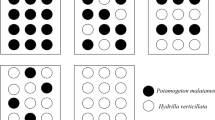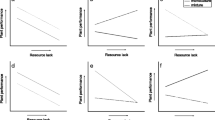Summary
In a previous paper in this series a model was proposed lor the competition between plant populations with different rooting depths. This model predicts that in mixtures of plant populations with different rooting depths the Relative Yield Total will exceed unity. Secondly it predicts that in these mixtures the relative crowding coefficient of the deep rooting population with respect to the shallow rooting one will decrease with increasing plant frequency. Two competition experiments in deep pots are carried out to test these predictions. In the first experiment a comparison is made between a series in which nutrients limited plant growth severely and a series in which nutrients were applied in a quantity that allowed high productivity. In the nutrient poor series the Relative Yield Total exceeded unity by about twenty per cent, while in the nutrient rich series only a small deviation from one was observed. The second experiment was divided into a series of deep pots in which different rooting depths were possible and a series of shallow pots in which the two species were forced to share the same space. In the series of shallow pots the relative crowding coefficient of the two species was found to be independent of plant frequency. In the series of deep pots the relative corowding coefficient of the two species with respect to each other did decrease significantly with increasing frequency.
The observed frequency-dependence for the shallow rooting species could be explained by an extension of the theory presented previously. In the spacing series used in the same experiment a decrease of the shoot to root ratio with increasing plant density was observed. Furthermore, in the replacement series the shoot to root ratio in mixture was found to be lower than in monoculture. The consequences of these phenomena for the estimation of the relative crowding coefficient and the Relative Yield Total on the basis of shoot weights are discussed. However, it is argued that the fact that shoot to root ratios change with plant frequency does not provide an alternative explanation for the frequency-dependence observed.
Similar content being viewed by others
References
Ayala FJ (1971) Competition between species: Frequency dependence. Science 171:820–824
Berendse F (1979) Competition between plant populations with different rooting depths I. Theoretical considerations Oecologia (Berl) 43:19–26
Bergh JP van den (1979) Changes in the composition of mixed populations of grassland species. In: MJA Werger (ed), The study of vegetation. Junk, The Hague p 59–80
Braakhekke WG: On coexistence: a causal approach to diversity and stability of grassland vegetation (in prep)
Brouwer R (1962a) Distribution of dry matter in the plant. Neth J Agric Sci 10:361–376
Brouwer R (1962b) Nutritive influences on the distribution of dry matter in the plant. Neth J Agric Sci 10:399–408
Ellern SJ, Harper, JL, Sagar GR (1970) A comparative study of the distribution of the roots of Avena fatua and A. strigosa in mixed stands using a 14C-labelling technique. J Ecol 58:865–868
Ennik GC (1970) White clover grass relationships: competition effects in laboratory and field. In: J Lowe (ed) White clover research. Occ Symp No 6 Brit Grassl Soc, Belfast, p 165–174
Harper JL, McNaughton IH (1962) The comparative biology of closely related species living in the same area VII. Interference between individuals in pure and mixed populations of Papaver species. New Phytol 61:175–188
Kruijne AA, Vries DM de, Mooi A (1967) Bijdrage tot de oecologie van de Nederlandse graslandplanten. Versl Landbouwk Onderz 696:1–65
Marshall DR, Jain SK (1969) Interference in pure and mixed populations of Avena fatua and A. barbata. J Ecol 57:251–270
Novozamsky I, Eck R van, Schouwenburg JCh van, Walinga I (1974) Total nitrogen determination in plant materials by means of the indophenol-bluc method. Neth J Agric Sci 22:3–5
Putwain PD, Harper JL (1972) Studies in the dynamics of plant populations V. Mechanisms governing the sex ratio in Rumex acetosa and Rumex acetosella. J Ecol 60:113–129
Throughton A (1955) The application of the allometric formula to the study of the relationship between the roots and shoots of young grass plants. Agric Prog 30:59–65
Trenbath BR (1975) Neighbour effects in the genus Avena III. A diallel approach. J Appl Ecol 12:189–200
Wallace B (1974) Studies on intra- and inter-specific competition in Drosophila. Ecology 55:227–244
Wit CT de (1960) On competition. Versl Landbouwk Onderz 66(8):1–82
Wit CT de, Bergh JP van den (1965) Competition between herbage plants. Neth J Agric Sci 13:212–221
Wit CT de, Tow GP, Ennik GC (1966) Competition between legumes and grasses. Versl Landbouwk Onderz 687:1–30
Author information
Authors and Affiliations
Additional information
Grassland Research Group Publication No. 33
Rights and permissions
About this article
Cite this article
Berendse, F. Competition between plant populations with different rooting depths II. Pot experiments. Oecologia 48, 334–341 (1981). https://doi.org/10.1007/BF00346491
Received:
Issue Date:
DOI: https://doi.org/10.1007/BF00346491




